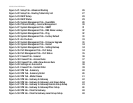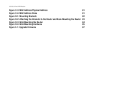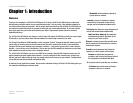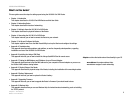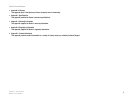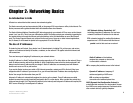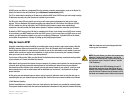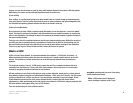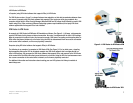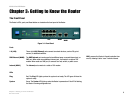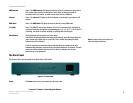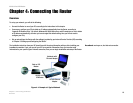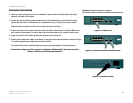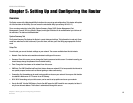
5
Chapter 2: Networking Basics
Why do I need a VPN?
10/100 8-Port VPN Router
A DHCP server can either be a designated PC on the network or another network device, such as the Router. By
default, the Router’s Internet Connection Type is Obtain an IP automatically (DHCP).
The PC or network device obtaining an IP address is called the DHCP client. DHCP frees you from having to assign
IP addresses manually every time a new user is added to your network.
For DSL users, many ISPs may require you to log on with a user name and password to gain access to the
Internet. This is a dedicated, high-speed connection type called Point to Point Protocol over Ethernet (PPPoE).
PPPoE is similar to a dial-up connection, but PPPoE does not dial a phone number when establishing a
connection. It also will provide the Router with a dynamic IP address to establish a connection to the Internet.
By default, a DHCP server (on the LAN side) is enabled on the Router. If you already have a DHCP server running
on your network, you MUST disable one of the two DHCP servers. If you run more than one DHCP server on your
network, you will experience network errors, such as conflicting IP addresses. To disable DHCP on the Router,
see the Basic Setup section in “Chapter 5: Setting up and Configuring the Router.”
Why do I need a VPN?
Computer networking provides a flexibility not available when using an archaic, paper-based system. With this
flexibility, however, comes an increased risk in security. This is why firewalls were first introduced. Firewalls
help to protect data inside of a local network. But what do you do once information is sent outside of your local
network, when e-mails are sent to their destination, or when you have to connect to your company's network
when you are out on the road? How is your data protected?
That is when a VPN can help. VPNs are called Virtual Private Networks because they secure data moving outside
of your network as if it were still within that network.
When data is sent out across the Internet from your computer, it is always open to attacks. You may already have
a firewall, which will help protect data moving around or held within your network from being corrupted or
intercepted by entities outside of your network, but once data moves outside of your network - when you send
data to someone via e-mail or communicate with an individual over the Internet - the firewall will no longer
protect that data.
At this point, your data becomes open to hackers using a variety of methods to steal not only the data you are
transmitting but also your network login and security data. Some of the most common methods are as follows:
1) MAC Address Spoofing
Packets transmitted over a network, either your local network or the Internet, are preceded by a packet header.
These packet headers contain both the source and destination information for that packet to transmit efficiently.
LAN: the computers and networking products that
make up your local network
NOTE: Since the Router is a device that connects two
networks, it needs two IP addresses—one for the
LAN, and one for the Internet. In this User Guide, you’ll
see references to the “Internet IP address” and the
“LAN IP address.”
Since the Router uses NAT technology, the only IP
address that can be seen from the Internet for your
network is the Router’s Internet IP address. However,
even this Internet IP address can be blocked, so that
the Router and network seem invisible to the Internet.




